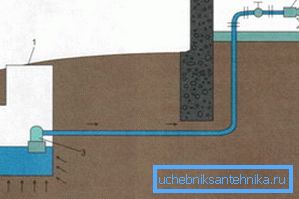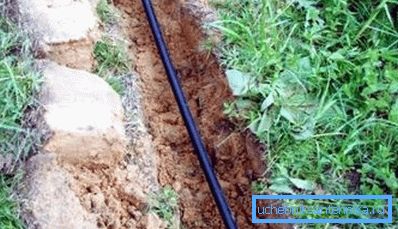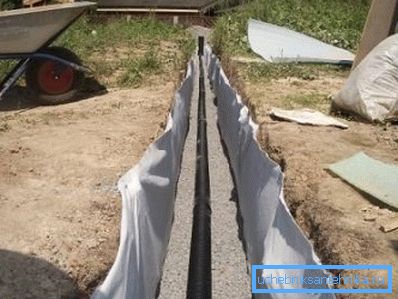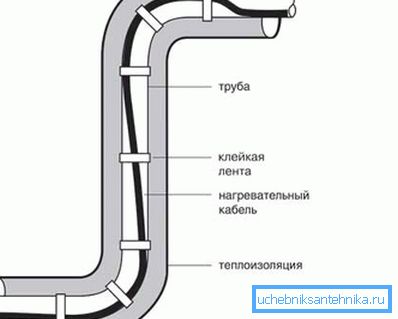At what depth to lay the water supply - the main
Living in a private house involves the summing up of all communications on an individual basis, and it is not always possible to find clear information on the depth to which the water supply system is laid. That is why we consider the basic information on this topic and understand everything: from how deep to dig a trench under the water supply system, to properly join the main line and arrange entry into the house.

Tip! If you are using wage labor and you are digging a trench for workers or special equipment, you should control the depth, as unscrupulous workers can go deeper than they should, and you will have big problems in the winter.
Types of pipes used for laying in the ground
The material for the manufacture of structures can be very different, so it is important to choose the best option on the market:
| Steel | This option was used in all the old communications, but every year it is replaced by more advanced options. Steel is corroded, and over time on the inner walls can accumulate so much plaque that the diameter decreases by half, and even tripled |
| Galvanized steel | A thin layer of zinc on the surface not only increases the resistance of pipes to corrosion several times, but also prevents the deposition of plaque on the walls for several decades. But some experts have doubts about the safety of this option when used in drinking systems. |
| Metal plastic | One of the new variants is a tubular product made of polymer, inside of which a metal frame is present for rigidity. This option has high performance and is not subject to corrosion processes, provided that the ends are protected from water |
| HDPE | Low-pressure polyethylene is one of those options that are practically without drawbacks and at the same time have a number of advantages: low price, resistance to oxidation and corrosion, and low weight. Another important advantage is the flexibility of the elements, thanks to which you can easily go around obstacles. |

How to determine the optimal depth
The depth of the water pipeline depends on many factors, below we consider the most important and significant ones. The main thing is not to miss the important nuances, since the alteration will cost as much as the main work.
Factors Influencing Deepening
When calculating the estimated depth, it is important to remember the following recommendations:
- Too much depth of laying water pipe into the ground is as undesirable as too shallow.. Excessive burial causes increased loads on the structure; in addition, this is directly related to a significant increase in the labor intensity of the work process and the difficulty of carrying out repair work thereafter.

- The lowest temperature values during the winter period of time should also be taken into account - the depth of the water supply system in a private house should be sufficient for the system to maintain its operation even at the most frost.. That is, you always need to give some stock so as not to worry about the safety of communications.
- If the relief of the territory is difficult or the terrain is sloping, then the depth should be increased., since on such plots the earth freezes through much deeper than on flat ground.

- It is also necessary to know the type of soil, as the depth of the trench for water mains directly depends on this.. Moreover, the difference can be very, very large, so it is better to check with your neighbors or in the appropriate organization what type of soil is at the location of your backyard.
- If the groundwater lies close to the surface, then laying the pipes at the required depth is unlikely to work. The same applies to cases when large stone blocks and layers with a dense, rocky structure are caught in the ground.

Note! It should be remembered that the most accurate result can be obtained only after a rather complicated heat engineering calculation, which can only be carried out by professionals involved in such work. This takes into account all of the above factors.
Some data regarding the depth of the pipeline
If you need a SNiP for the depth of the water supply, then you should look for the regulation under the number II-D.3-62 under the name Water Supply Design Standards. In this document you can find all the necessary data.

The document has tables in which the depth of laying of pipes for water supply is reflected, depending on the region in which the work is carried out.
Consider an example for central Russia:
- Stony soils with large fractions in the composition freeze through the deepest of all, the depth of laying on them is at least 1.9 meters.
- Gravel soils with a lot of pebble and quite granular sand also freeze deeply, therefore pipes need to be laid no less than 1.72 meters from the surface.
- Sandy areas and places dominated by sandy loams have a more dense structure, therefore the depth is about 1.61 meters.
- And finally, clay soils and loams freeze through the least, so communication can be laid on them at a depth of just 1.32 meters.
If we are talking about the northern areas, the figures increase by several times, and if we consider the southern areas, the pipes can be laid very finely - from half a meter to a meter.
Consider whether there is at least a depth to dig the water supply, everything is very simple - the pipe is laid at least 50 cm from the surface of the earth. This value was not chosen by chance, since only at such a burial can we guarantee that communications will not be damaged by a passing vehicle and able to withstand other loads.

Some rules of laying
Bumping into the central plumbing with your own hands is strictly prohibited, but even if the work is performed by employees, you should know the basic rules for high-quality installation:
- Insert into the pipe is carried out in a special well, if it is not nearby, then you should build a brick construction in the most convenient place for you.
- If you have made a calculation of how deep the water supply is to be buried, then you shouldn’t do additional research. Thermal calculation is accurate and rarely wrong.
- The trench should not cross other communications, otherwise problems may arise during installation. This is verified at the design stage.
- After digging, the bottom is leveled and filled with an even layer of rubble. This will create a reliable cushion that will increase reliability.
- To lay the HDPE pipe, do not need any instructions and complex guidance. Everything is quite simple and easy: the product is unwound and embedded in a trench.
- Even if the standard plumbing depth is observed - the pipe is inserted vertically into the house, therefore, this place will most likely freeze. Therefore, the riser is necessarily insulated or wrapped with a special heating cable for heating pipes.

Conclusion
As you can see, the correct calculation of the depth is very important for the system to work at any time of the year. The video in this article will help to understand the information presented even better.